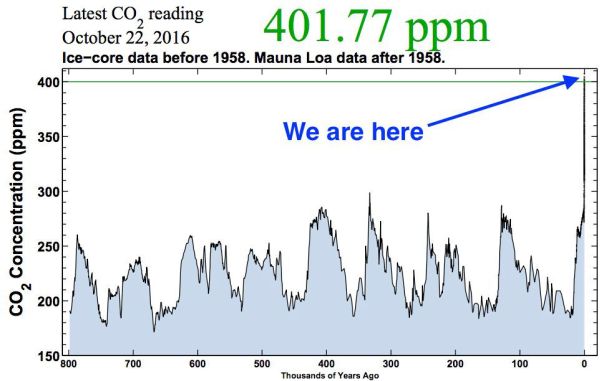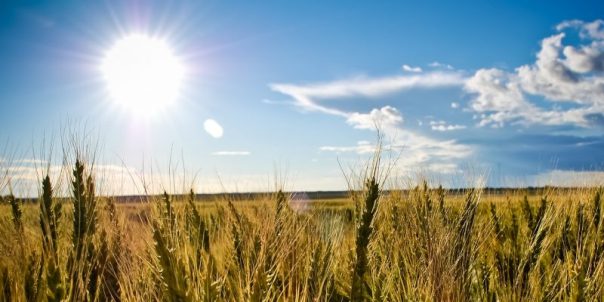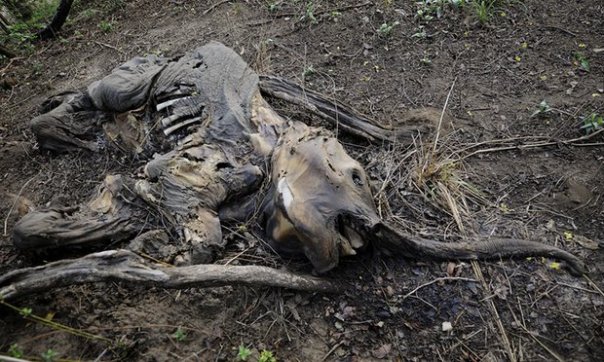
800,000-year history of carbon dioxide levels in Earth’s atmosphere, showing the recent spike. Image: Scripps institution of oceanography/mashable
Oldspeak: “The rate at which greenhouse gases like carbon dioxide and methane are accumulating in the air guarantees that growing impacts from climate change, ranging from rising sea levels to hotter heat waves and ocean acidification, will continue to occur and in fact worsen in coming decades.” Yeah. So that’s happening too. Another blaring alarm, largely ignored. Never mind that it has “profound consequences for everyone alive today.” We have made the arrogant and ignoble mistake of assigning greater importance to our human-created systems & less importance to the natural ecology upon which we depend for survival. That mistake will likely be fatal. Though I suspect 350.org and their greenwashed non-profit industrial complex ilk, will continue passionately rallying the “protest” troops and raising funds until we fucking choke on our toxic exhaust. “-OSJ
Written By Andrew Freedman @ Mashable:
According to the World Meteorological Organization (WMO), observatories around the world found that in 2015 and 2016, the amount of carbon dioxide in the atmosphere crossed the symbolic threshold of 400 parts per million (ppm), and that this is likely to remain the case for the foreseeable future.
This is the highest level ever seen in all of human history and is 144 percent higher than the pre-industrial average. Such a high level is also very likely the highest on record going back to between 800,000 and 15 million years ago, based on various studies.
For perspective, scientists have found that previous periods with similar carbon dioxide levels — all of which occurred before modern humans evolved — had far higher global average temperatures and sea levels than today. In some cases, such periods had global average sea levels of 100 feet higher than today.
Many scientists think that avoiding dangerous climate change will require getting carbon dioxide concentrations down to 350 parts per million, which will require massive emissions cuts and new technologies to push annual emissions into negative numbers.
While the planet was flirting with the 400 ppm mark on a month-to-month basis at some observatories, it had not yet breached the line worldwide for an entire year until 2015, the WMO found in a report released Monday.
The rate at which greenhouse gases like carbon dioxide and methane are accumulating in the air guarantees that growing impacts from climate change, ranging from rising sea levels to hotter heat waves and ocean acidification, will continue to occur and in fact worsen in coming decades.
 Carbon dioxide levels in 2016, with various emissions scenarios projected through 2100.
Carbon dioxide levels in 2016, with various emissions scenarios projected through 2100.
Image: Climate Central
This is in part because carbon dioxide can last in the air for thousands of years, which is why environmental advocates and policymakers say we only have one to two decades at most to act before an unsafe amount of climate change is essentially baked into the climate system.
The WMO report found there was a nearly 40 percent increase in the warming effect on our climate (technically known as “radiative forcing”) between 1990 and 2015, due to the increase in greenhouse gases in the air.
Scientists at the greenhouse gas monitoring station high atop Mauna Loa in Hawaii have said that carbon dioxide levels will not dip below 400 ppm for many generations, according to a WMO press release on Monday.
In fact, last year saw the largest annual spike in greenhouse gas concentrations on record.
Part of this sharp annual uptick is due to the strong 2015-16 El Niño event, which caused droughts in tropical areas that normally absorb carbon as so-called “sinks.”
Drier than average weather in such areas, including Indonesia, reduced the ability of tropical forests to suck up as much carbon dioxide as they usually do, and increased the occurrence of forest fires that release carbon dioxide into the air.
“The El Niño event has disappeared,” Taalas said. “Climate change has not.”

